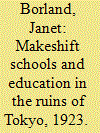| Srl | Item |
| 1 |
ID:
088121


|
|
|
|
|
| Publication |
2009.
|
| Summary/Abstract |
A range of issues confronted government officials in the aftermath of the Great Kant? Earthquake, but almost immediately they began efforts to resume education. This article examines how educators overcame numerous challenges in order to recommence primary school education and return children to makeshift classrooms in the ruins of Tokyo. Education was viewed as an important means to help restore a sense of normality in the lives of displaced school children at this time of extraordinary upheaval. Educators were concerned not only with the material reconstruction and recovery of schools, but also the physical and mental recovery of children.
|
|
|
|
|
|
|
|
|
|
|
|
|
|
|
|
| 2 |
ID:
150573


|
|
|
|
|
| Summary/Abstract |
Tokyo’s school children began writing essays about the Great Kantō Earthquake within weeks of the disaster as a simple pedagogical exercise. These remarkable accounts provide a panoramic view into children’s first-hand experiences of Japan’s worst natural disaster and daily life in the aftermath. Their usefulness, however, does not end there. In the period following the 1923 earthquake, children possessed a new and different utility to the state as the future generation to be listened to, learned from, and inspired by. Children’s essays struck a fine balance between reflecting on the past and dreaming of a better future. Moreover, they were ideal role models of resilience in an era of spiritual and physical reconstruction. Their promises to study hard, save money, and reconstruct Tokyo ‘even better than before’ represented exactly the kind of values that government officials wanted to cultivate in 1920s Japan.
|
|
|
|
|
|
|
|
|
|
|
|
|
|
|
|